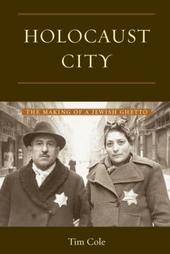
|
Holocaust City: The Making of a Jewish Ghetto
Paperback
Main Details
| Title |
Holocaust City: The Making of a Jewish Ghetto
|
| Authors and Contributors |
By (author) Tim Cole
|
| Physical Properties |
| Format:Paperback | | Pages:272 | | Dimensions(mm): Height 229,Width 152 |
|
| Category/Genre | The Holocaust
Second world war |
|---|
| ISBN/Barcode |
9780415929691
|
| Classifications | Dewey:940.53180943912 |
|---|
| Audience | | General | | Professional & Vocational | | Tertiary Education (US: College) | |
|---|
| Illustrations |
10 black & white illustrations, 10 colour illustrations
|
|
Publishing Details |
| Publisher |
Taylor & Francis Ltd
|
| Imprint |
Routledge Member of the Taylor and Francis Group
|
| Publication Date |
19 June 2003 |
| Publication Country |
United States
|
Description
Tim Cole's first book, Selling the Holocaust , explained how the Holocaust has been mythologized in popular culture. With his new book, Holocaust City , Cole again covers new and provocative ground by detailing how the Holocaust was literally constructed, planned and built. Drawing from the ideas of critical geography and based on extensive archival research, Cole chillingly examines such concepts as "Nazi space" versus "Jewish space" - the first a living space of authority and control and, the second, a space designated for death. Cole brilliantly reconstructs the formation of the Jewish ghetto during the Holocaust, focusing primarily on the ghetto in Budapest, Hungary - one of the largest created during the war, but rarely examined. Cole maps the city illustrating how spaces - cafes, theaters, bars, bathhouses - became divided in two. Throughout the book, Cole discusses how the creation of this Jewish ghetto, just like the others being built across occupied Europe, tells us agreat deal about the nature of Nazism; what life was like under Nazi-occupation; and the role the ghetto actually played in the Final Solution. A major contribution to Holocaust studies, Cole's groundbreaking work shows that the architecture of the Holocaust is not the monumental buildings and plans of Albert Speer, but the more modest buildings and structures made for deadly function: the locking gates of the ghetto, the crematorium oven doors. By giving readers a glimpse of daily life in the "Holocaust City", Cole adds to the ongoing debate sparked by Hitler's Willing Executioners about the culpability of people during World War II.
Author Biography
Tim Cole, a respected historian on the Holocaust, is Lecturer of European Social History at the University of Bristol. Cole has written widely on the topic and his previous book, Selling the Holocaust: From Auschwitz to Schindler, How History is Bought, Packaged, and Sold (Routledge, 1999), received wide media attention and critical praise.
Reviews"A bold contribution to our understanding of the Shoah. Cole patiently unravels the layered complex of ideological motivations, economic ambitions, social realities and military contingencies that informed the decisions of politicians and officials who set out to separate Jews from gentiles in war-time Budapest. "Holocaust City is an important book that, like Christopher Browning's "Ordinary Men, will inspire a new genre of analysis of the Shoah as the greatest catastrophe western civilization both endured and permitted.."
-Robert Jan van Pelt, co-author of "Holocaust: A History
"Tim Cole's new cultural history takes the study of space, cityscape, and the very role of the ghetto in the mass murder of Europe's Jews to revealing new levels. It will provoke and challenge readers to re-think and re-see the ghetto for what it was--an actual place and way station to death, and something that also had to be imagined conceptually and then graphically designed by the Nazis for their persecution of the Jews. This is a provocative and important book.."
-James E. Young, author of "The Texture of Memory: Holocaust Memorials and Meaning
"Cole's analysis of the subtle dynamics between state and local policy and the use of space goes a long way towards clarifying how ghettoization became an act of urban planning in Nazi-dominated Europe.."
-Paul B. Jaskot, author of "The Architecture of Oppression: The SS, Forced Labor and the Nazi Monumental Building Economy
..."Tim Cole reconstructs the formation of the Jewish ghetto during the Holocaust, focusing primarily on the ghetto in Budapest, Hungary. Cole maps the city, illustrating how spaces...became divided in two. He discusses howthe creation of the Jewish ghetto tells us much about the nature of Nazism.."
-Shofar
|